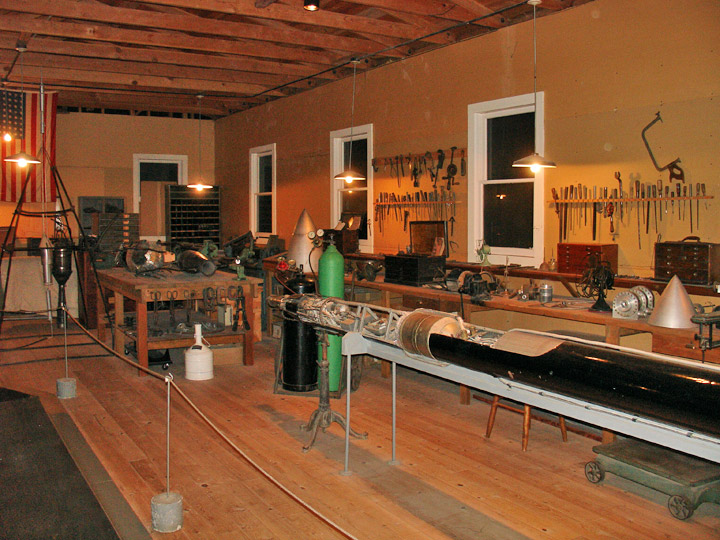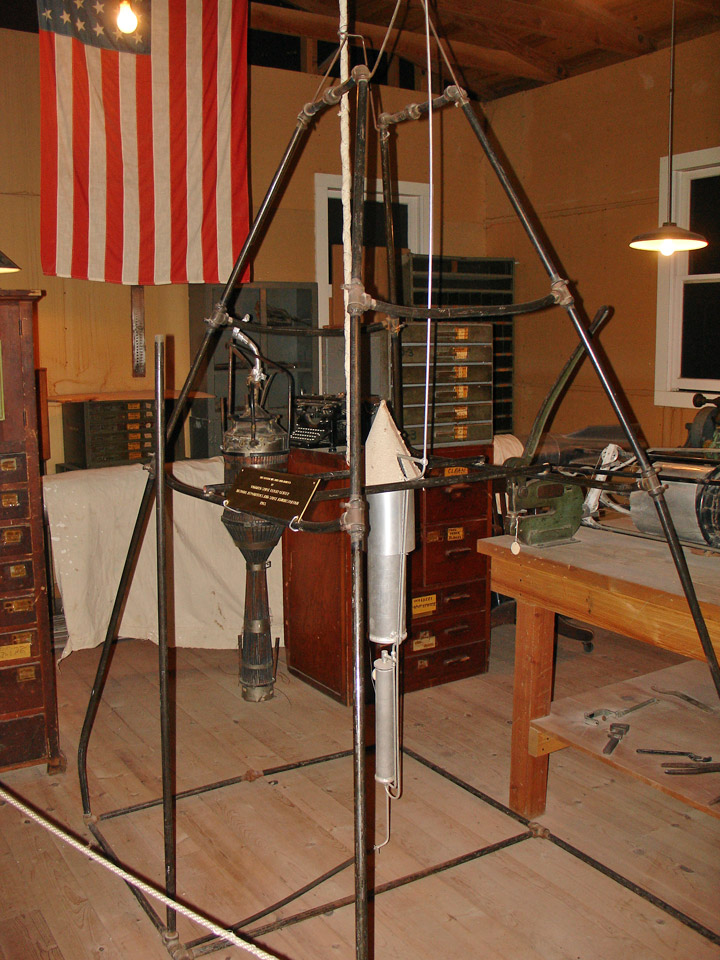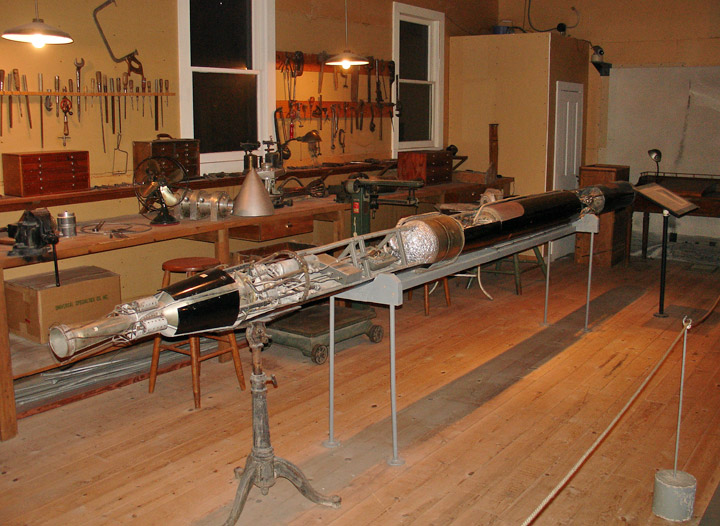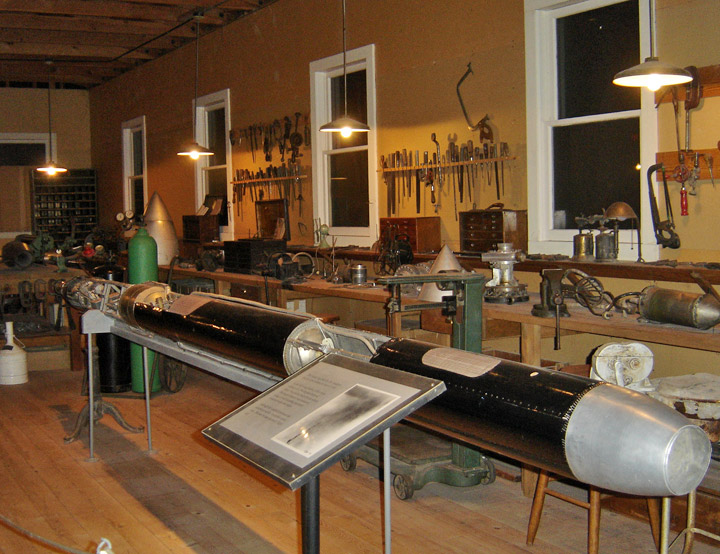

Robert Goddard Museum

Goddard workshop
Robert Hutchings Goddard, Ph.D.
(October 5, 1882 – August 10, 1945), U.S. professor and scientist, was a pioneer
of controlled, liquid-fueled rocketry. He launched the world's first
liquid-fueled rocket on March 16, 1926. From 1930 to 1935 he launched rockets
that attained speeds of up to 885 km/h (550 mph). Though his work in the field
was revolutionary, he was sometimes ridiculed for his theories. He received
little recognition during his lifetime, but would eventually come to be called
one of the fathers of modern rocketry for his life's work.
Robert Goddard was born in Worcester, Massachusetts to Nahum Danford Goddard
(1859–1928) and Fannie Louise Hoyt (1864–1920). Robert was their only child to
live to adulthood. Another, younger, son was born with physical disabilities,
and died not long after birth. When the age of electric power
began to take shape in U.S. cities in the 1880s, the young Goddard became
interested in science. When his father showed him how to generate static
electricity on the family's carpet, the five-year-old's imagination was
inspired. Robert experimented, believing he could jump higher if the zinc in
batteries could somehow be charged with static electricity. The experiments
failed, but his imagination would continue undiminished.
Goddard developed a fascination with flight, first with kites and then with
balloons. He also became a thorough diarist and documenter of his own work, a
skill that would greatly benefit his later career. These interests merged at age
16, when Goddard attempted to construct a balloon made with aluminum, shaping
the raw metal in his home workshop. After nearly five weeks of methodical,
documented efforts, he finally abandoned the project. However, the lesson of
this failure did not restrain Goddard's growing determination and confidence in
his work.
He became interested in space when he read H.G. Wells's science fiction classic
The War of the Worlds when he was 16 years old. His dedication to pursuing
rocketry became fixed on October 19, 1899. While climbing a cherry tree to cut
off dead limbs, he imagined, as he later wrote, "how wonderful it would be to
make some device which had even the possibility of ascending to Mars, and how it
would look on a small scale, if sent up from the meadow at my feet." For the
rest of his life he observed October 19 as "Anniversary Day", a private
commemoration of the day of his greatest inspiration.
A thin and frail boy, almost always in fragile health from stomach problems,
Goddard fell two years behind his school classmates. He became a voracious
reader, regularly visiting the local public library to borrow books on the
physical sciences. Later, he continued his formal schooling as an 18-year-old
sophomore at South High School in Worcester. His peers twice elected him class
president. At his graduation ceremony in 1904, he gave his class oration as
valedictorian. In his speech, Goddard included a phrase that would become
emblematic of his life: "It has often proved true that the dream of yesterday is
the hope of today, and the reality of tomorrow." Goddard enrolled at Worcester
Polytechnic Institute in 1904. He quickly impressed the head of the physics
department, A. Wilmer Duff, with his thirst for knowledge. Professor Duff took
him on as a laboratory assistant and tutor.
His social activities continued at Worcester. He joined the Sigma Alpha Epsilon
fraternity, and began a long courtship with Miriam Olmstead, an honor student
who was second in his high school class. Eventually, she and Goddard were
engaged, but they drifted apart, and the engagement ended around 1909.
While still an undergraduate, Goddard wrote a paper proposing a method for
“balancing aeroplanes,” and submitted the idea to Scientific American, which
published the paper in 1907. Goddard later wrote in his diaries that he believed
his paper was the first proposal of a way to stabilize aircraft in flight. His
proposal came around the same time as other scientists were making breakthroughs
in developing functional gyroscopes.
Goddard received his B.S. degree in physics from Worcester Polytechnic Institute
in 1908, and then enrolled at Clark University in the fall of that year.

early Goddard rocket
His first writing on the possibility of a liquid-fueled rocket came in February
1909. Goddard had begun to study ways of increasing a rocket’s energy efficiency
using methods alternative to conventional, powder rockets. He wrote in his
journal about an idea of using liquid hydrogen as a fuel with liquid oxygen as
the oxidizer. He believed a 50 percent efficiency could be achieved with liquid
fuel, an efficiency much greater than that of conventional rockets.
Goddard received his M.A. degree from Clark University in 1910, and then
completed his Ph.D. at Clark in 1911. In 1912, he accepted a research fellowship
at Princeton University.
Goddard launched the first
liquid-fueled rocket on March 16, 1926 in Auburn, Massachusetts. His journal
entry of the event was notable for its laconic understatement: "The first flight
with a rocket using liquid propellants was made yesterday at Aunt Effie's farm."
(The launch site is now a National Historic Landmark, the Goddard Rocket
Launching Site.)
The rocket, which was dubbed "Nell", rose just 41 feet during a 2.5-second
flight that ended in a cabbage field, but it was an important demonstration that
liquid-fuel propellants were possible.
Viewers familiar with more modern rocket designs may find it difficult, on
viewing the well-known picture of "Nell", to distinguish the rocket from its
launching apparatus. The complete rocket is significantly taller than Goddard,
but does not include the pyramidal support structure which he grasps.
The rocket's combustion chamber is the small cylinder at the top; the nozzle is
visible beneath it. The fuel tank, which is also part of the rocket, is the
larger cylinder opposite Goddard's torso. The fuel tank is directly beneath the
nozzle, and is protected from the motor's exhaust by an asbestos cone.
Asbestos-wrapped aluminum tubes connect the motor to the tanks, providing both
support and fuel transport. Improved understanding of rocket dynamics, and
the availability of more sophisticated control systems, rendered this design—in
which a motor at the top pulls the rocket—obsolete, supplanted by the now
familiar design in which the motor is located at the bottom and pushes the
rocket from behind.
After a launch of one of Goddard's rockets in July 1929 again gained the
attention of the newspapers, Charles Lindbergh learned of his work. At the time,
Lindbergh had begun to wonder what would become of aviation in the distant
future, and had settled on rocket flight as a probable next step. He contacted
Goddard in November 1929. The professor met the aviator soon after in Goddard's
office at Clark University. Upon meeting Goddard, Lindbergh was immediately
impressed by his research, and Goddard was similarly impressed by the flier's
interest. He discussed his work openly with Lindbergh, finding a mutual alliance
with Lindbergh that was to last for the rest of his life.

By late 1929, Goddard had been attracting additional notoriety with each rocket
launch. He was finding it increasingly difficult to conduct his research without
unwanted distractions. Lindbergh discussed finding additional financing for
Goddard's work, and put his famous name to work for Goddard. Into 1930,
Lindbergh made several proposals to industry and private investors for funding,
which proved all but impossible to find following the recent U.S. stock market
crash in October 1929.
Lindbergh finally found an ally in the Guggenheim family. Financier Daniel
Guggenheim agreed to fund Goddard's research over the next four years for a
total of $100,000. The Guggenheim family, especially Harry Guggenheim, would
continue to support Goddard's work in the years to follow.
With new financial backing, Goddard eventually relocated to Roswell, New Mexico
(long before the area became the center of the UFO craze) where he worked in
near isolation for a dozen years, and where a high school was later named after
him. Though he brought his work in rocketry to the attention of the United
States Army, he was rebuffed, since the Army largely failed to grasp the
military application of rockets.
In Nazi Germany, however, Wernher von Braun took Goddard's plans from various
journals and incorporated them into building the early 1930s A-1 and A2
prototypes of the Aggregate series that later, designated A4 or V-2, constantly
struck at Europe in the last two years of World War Two. In 1963, von Braun,
reflecting on the history of rocketry, said of Goddard: "His rockets ... may
have been rather crude by present-day standards, but they blazed the trail and
incorporated many features used in our most modern rockets and space vehicles".
Goddard was the center of a famous espionage operation involving the German
Intelligence Agency, Abwehr and an operative called Nikolaus Ritter. Being the
head of the agency's U.S. operations, Ritter recruited a source who infiltrated
the circle around Goddard, leaking his discoveries to the Germans.
Goddard was nonetheless extremely secretive. In August of 1936, he was visited
by Frank Malina, who was then studying rocketry at the California Institute of
Technology. Goddard declined to discuss any of his research, other than that
which had already been published in Liquid-Propellant Rocket Development. This
deeply troubled Theodore von Kármán, who was at that time Malina's mentor.
Later, von Kármán wrote, "Naturally we at Cal Tech wanted as much information as
we could get from Goddard for our mutual benefit. But Goddard believed in
secrecy.... The trouble with secrecy is that one can easily go in the wrong
direction and never know it." By 1939, von Kármán's Guggenheim Aeronautical
Laboratory at Cal Tech had received Army Air Corps funding to develop rockets to
assist in aircraft take-off. Goddard learned of this in 1940, and openly
expressed his displeasure.

Goddard rocket
After his offer to develop rockets for the Army was declined, Goddard
temporarily gave up his preferred field to work on experimental aircraft for the
U.S. Navy. After the war ended, Goddard was able to inspect captured German
V-2s, many components of which he recognized. However, Goddard would not design
any more rockets of his own.
He learned he had throat cancer in 1945, and died that year in Baltimore,
Maryland. He was buried in Hope Cemetery in his home town of Worcester,
Massachusetts.
Text from Wikipedia